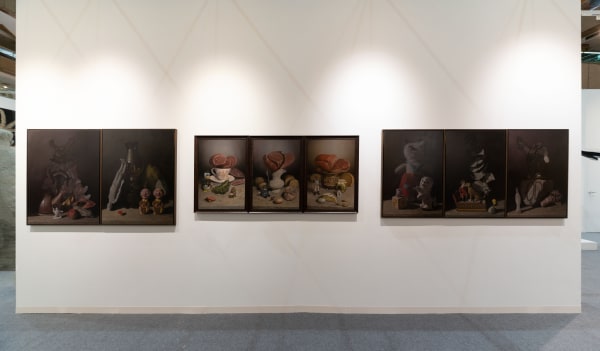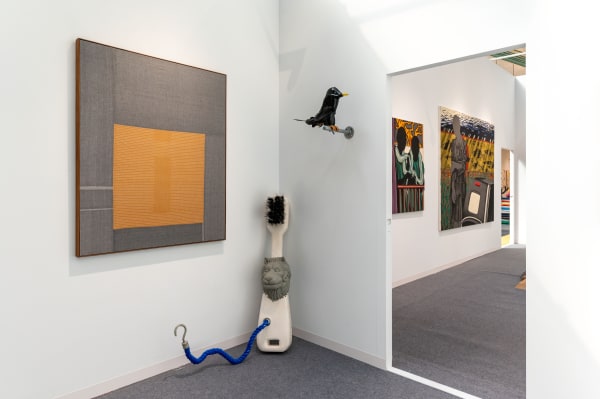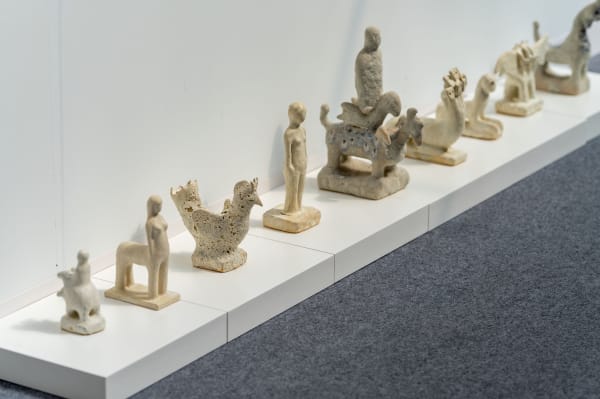Art Taipei 2023: 寂靜的春天
Past event
介紹
台北世界貿易中心展覽一館
Booth E04
《寂靜的春天》
「是誰開始這一連串下毒的行動,使死亡像小石投進靜止的池塘般引起漣漪,逐漸往外擴散?是誰在天平的一邊,放下可能會被甲蟲吃掉的葉子,而在另外一邊放入一堆五彩繽紛,遭毒害的鳥兒遺留下來的羽毛?是誰有權力,為無數不知情的人決定說,沒有昆蟲的世界是最好的,縱使是不毛的世界也是值得,而空中展翼飛翔的鳥兒糟蹋了這樣的世界?」—《寂靜的春天》(第8章),不再有鳥兒歌唱。
伊日藝術計劃將於2023年台北國際藝術博覽會中,以瑞秋·卡森(Rachel Carson)於1962年出版的《寂靜的春天》(The Silent Spring)為展覽命名與核心主題。此展旨在喚起大眾所遺忘的環境議題並予以關注,提出當代藝術家們如何超越人類中心的視角,探討人與環境之間的多維度關係,並以創作作為回應。
瑞秋·卡森於此書融合了科學數據和生物學的角度,描繪了因戰爭而發展出的化學物質被用於殺蟲。人類以無知的方式試圖控制大自然,透過噴灑農藥解決了蚊蟲和農業問題的表面,卻導致鳥類大量消失,以及其他物種發生變異。
「其實,化學物質污染水質最可怕的一面,是河水、湖水或蓄水池,甚至是餐桌上的一杯水中,都含有一堆混合的化學物質,[...]。」—《寂靜的春天》(第4章),地球的水。
《寂靜的春天》一書不僅深遠影響了人類宰制下的自然與經濟活動,更啟發了「世界地球日」的誕生,同時改變了藝術世界中觀看與想像自然的思維方式。此展轉換了以往觀看自然之視角,將經典風景題材通過環境反思後重新觀看,自然似乎成為了心中那座逝去的桃花源,藝術家們若有似無的於創作中夾帶著對自然的懷念之情。藝術家在現今與工業革命前對於「春天」的思考方式已經有所不同。在二十世紀末的一系列環境思潮之後,他們在面對自然時,所謂地「真實性」也有了新的理解。
當代作品不約而同地出現人類與環境的衝突,這種藝術轉變反映了社會對生態意識的變化。例如作品中春之女神與精靈的形象轉化、化學性的螢光色調,又或是畫面中暴力下所產生的變異動物們。然而,儘管現實中衝突和挑戰依然存在,藝術家在畫面中操作了更具超越性的浪漫共存,描繪出人類與自然間渴望和諧共生的形象,宛如戀人般緊密相擁。這是對於現實世界的回應,以及維護生態平衡的迫切關注。
今天的自然景象的非正常演化,而是生態的激進反應,我們無法肯定的說,變異的動物們只存在於藝術家筆下。《寂靜的春天》在當今社會已成為強烈的象徵,春天永遠不該是安靜的。縱然在不安與躁動中,這個季節依然充滿生機與韌性。
參展藝術家:
亞歷山大・塞巴斯丁、鮑斯・米優斯、丹尼爾・蘇維勒斯、Grip Face、黃望福、詹姆斯・雷利、喬希・朱埃特、蘿拉・琳伯格、林羽龍、勞・羅斯、高木真希人、瑪塔・科拉達、馬蒂亞斯・加爾夫、小瀨真由子、邁可・麥格拉思、M. IRFAN、王鴻川、拉斐爾・巴德、坪山小百合、 三平硝子、中村太一、丸山太郎、泰特斯・麥比斯、丸尾康弘
展覽現場
影像







































